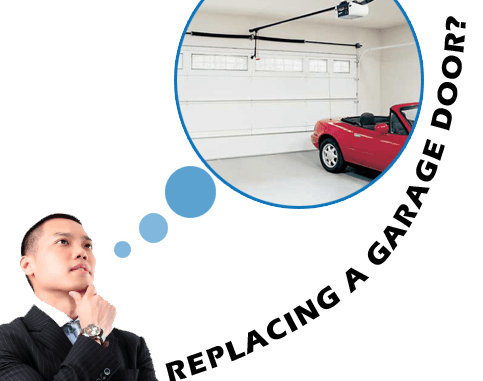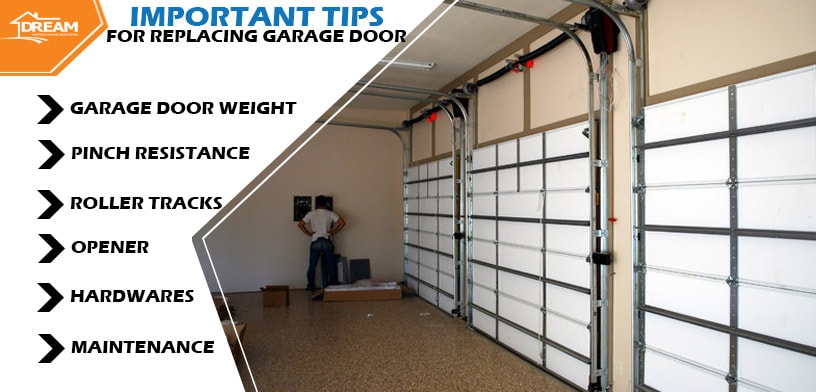Need a new garage door? Don’t worry—you don’t necessarily need to break the bank hiring a professional for installation. With these easy step-by-step instructions, you can take a DIY approach to garage door installation. In fact, if you’re relatively handy, this can be done in about 8 to 12 hours. However, keep in mind that while you can do the job alone, it’s probably best to recruit some help, especially when you’re removing the old garage door. We’re here to break down how you can remove your old garage door and install a brand new one. Let’s take a look at tips for replacing a garage door.
- Pick out a new garage door. A standard double garage door is typically 7 feet tall
and 16 feet wide, while a standard single garage door is typically 7 feet tall and between 8 and 9 feet wide. Because garage doors are so large and take up so much space, having a large in-store stock just isn’t feasible for most home stores and home centers. Therefore, keep in mind that you will probably need to order a garage door as opposed to walking into the store and buying it right off the shelf. Garage doors are available in wood, fiberglass, and steel. Steel garage doors tend to be the most resilient and durable. An affordable option, they are also lighter than other types of garage doors, and require less maintenance.
When choosing a new garage door, you want to choose a door that will maximize safety. Therefore you should keep following tips for replacing a garage door in mind when it comes to picking out a new garage door.
- Opt for a door that is lightweight. Garage door weight typically isn’t an issue as long as the springs are properly tensioned you won’t end up needing a garage door spring repair Los Angeles. Still, however, stay on the safe side by choosing a door that is relatively lightweight. Keep in mind that insulated double steel doors, for example, will typically weight somewhere between 150 and 200 lbs.
- Be sure to consider pinch resistance. The most common garage door injury is a finger that gets smashed—or even entirely cut off—when it gets trapped between the two sections of the garage door as it moves. The good news is that you can prevent these kinds of accidents by picking a door with pinch-resistant section designs.
- Make sure the springs have containment cables. It is advisable to purchase a garage door with containment cables that go through the center of the side-mounted extension springs, as this ensures that if an extension spring should break, the cable won’t turn into a heavy whip that could potentially damage your vehicle or, worse yet, injure people.

- Consider a safe automatic door opener. Always choose a garage door with an automatic opener that is equipped with both anauto-reversing mechanism and photoelectric eyes. This way, if the door is closing and something gets under it, such as a pet or a child, the beam between the eyes is interrupted and the door automatically reverses.
- Release the tension on the side-mounted springs. Now that you’ve chosen a new garage door, you’re probably excited to get it up and running. But before you do, there are a few things you need to do. First and foremost, you need to remove your old garage door. The first step in doing this is releasing the tension on the side-mounted springs. You need to lift the door and use a pair of locking pliers to lock each side of it in place. Once the door is secured, fasten the extension spring onto the roller track. From here, you will want to use the locking pliers to remove the cable from the bottom bracket.
- Install the roller tracks. Once you’ve removed your old garage door, the first step to installing your new garage door is to install the upper roller tracks. First, wrap the curved lip around the rollers, placing the top of these tracks roughly 8 inches below the top of the top section of the garage door. Be sure to double check that each of the rollers are level with one another before mounting them. Next, install the lower lower tracks, placing them about 8 inches above your garage floor.
- Replace all hardware. When you install a new garage door it is also a good idea to replace all the hardware. Keep in mind that for garage doors with an automatic opener, this includes a support strut and an opener bracket. Remember, it is important to mount all of the hardware securely in order to maximize the safety of your garage door.
- Eliminate all of the old stop material. Once your new garage door is installed and all of the hardware has been replaced, get rid of all the old stop material located on the exterior of the door. Ideally, you want to replace this old stop material with a new material that has a rubber weather strip gasket, which can be found at the majority of home stores and home centers. Make sure that the door is closed when you are installing this stop material. You should also ensure that the gasket is resting against the door at a 45-degree angle.
- Don’t forget about annual maintenance! A garage door is a big investment, and in order to ensure that the door enjoys a long life, without too many problems down the line, proper annual maintenance is absolutely key. Check the condition of all the cables once a year, to ensures that they aren’t worn or frayed, lubricate all rollers and springs, and make sure the door is both properly balanced and operating smoothly.
All in all, garage door replacement based on mentioned tips for replacing a garage door and save your self a significant amount of money in installation fees. All it takes is a bit of hard work and some patience!

